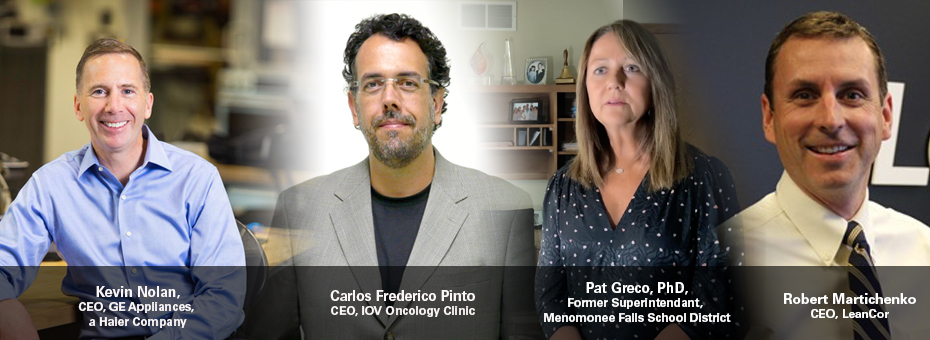Kevin Nolan may be the CEO of GE Appliances, a $7 billion company, but at heart he is an engineer, an engineer with high respect for the lowly screw.
“It’s a torture device,” Nolan said.
He didn’t always think that way. His epiphany about screws came a couple years ago on an assembly line where he and other executives, managers, and corporate lawyers worked as part of a “lean immersion” course to align the company’s lean enterprise transformation from the shop floor to the top floor.
“As an engineer, I thought nothing of putting 10 screws in a product design,” Nolan said. When he had to drive those 10 screws over and over on the line, they became torture devices, targets for limited use or elimination through continuous improvement in product design.
Execs from Manufacturing, Healthcare, Supply Chain, and Education
Nolan was one of four executives from four major areas of the economy – manufacturing, healthcare, supply chain, and education – who explained how they aligned organizations behind continuous improvement transformations during the second track of the Virtual Lean Learning Experience conference (VLX).
He was joined by presenters Robert Martichenko, senior vice president at Transplace and founding CEO of LeanCor; Carlos Frederico Pinto, MD, CEO, Instituto de Oncologia do Vale; Pat Greco, PhD, retired superintendent of schools, Menomonee Falls, WI, and senior director of thought leadership at Studer Education.
As part of GEA’s lean immersion program, which was internally developed, managers observed and performed assembly line work, wrote standardized work, and identified problems to solve using continuous improvement tools.
“This got broad buy-in,” Nolan said. “It fundamentally put us on a different path.” Management, which had viewed lean as a productivity and cost-reduction tool, now properly viewed it as a way to create a culture of continuous improvement at all levels.“We see engineering drawings as a team sport. Everyone’s involved.”
Other initiatives contributed to alignment around the new path. A scorecard published every six months identified progress or backsliding in hoshin, material flow, standardized work, and five other continuous improvement activities at the company’s six manufacturing facilities. A strategy deployment (hoshin) management process aligned vertically and horizontally company functions and activities with strategic objectives. The FirstBuild project, a product design studio open to the public, helped bring GEA product developers into line with what people wanted to buy.
A lean product and process development (LPPD) system diminished the “natural tension” between product development and manufacturing, Nolan said. LPPD is a system for creating successful new products and services simultaneously with the processes that will deliver them, such as manufacturing, marketing, and supply chain.
“We see engineering drawings as a team sport,” Nolan said. “Everyone’s involved.”
No Monotony in Menomonee Falls
Getting everyone involved in improvement from the boardroom to the classroom, was the goal of Pat Greco when she was school superintendent in Menomonee Falls. She told the VLX audience how her team transformed an underperforming school system into a high-performing one by building individual and collective capacity to improve. Menomonee Falls has remained a high-performing district through leadership transitions since her tenure.
“We know improvement is not a document,” she said. “We thought of it as a mindset and a skillset for building an army of improvers across the organization so that we can work effectively together.” Into the “army” she enlisted not only certified teachers but students, custodians, accountants, lawyers, and school board members to work toward aligning goals, actions, and processes.
We have to stop the blame so people don’t look at measurement as evil; they look at it as a way of learning to improve and grow.
Early on, she and her team met with area college officials and researched local industry needs so the school system could be an effective “pipeline” for higher education and business careers. Greco involved the leadership team in quarterly as well as annual meetings with the elected school board.
Alignment also relied on “scaffolding,” an improvement framework with measures and goals at the top, supported by a substructure of behavior and process development. It was buttressed by a balanced scorecard system to align day-to-day activities with strategy. It, in turn, was supported by departmental, team, and individual goals.
For measures, Greco prefers “the smaller the better.” They include, among others, the number of students and staff who meet goals, daily milestone assessments, daily attendance by students and teachers, feedback from students, staff, and parents, and financial performance. Standardized test scores are important for benchmarking but “cloud the conversation on performance.”
A “Big Wicked Challenge”
Progress toward goals was checked every 10 to 15 days for students, who paused and reflected on what was working in their learning and where they needed help. Students recorded their progress in “learning journals” and shared reflections with parents. As they get older, the journals feed into career planning.
Every 30 to 45 days departments and schools paused and reflected on what they were learning and decided what the next cycle of improvement should look like.
A “big, wicked challenge” for education nationally is applying technology to measurement in the service of improvement, according to Greco. She said that education and healthcare professionals need a “daily view” of data in a way that’s easy to use for improvement.
“Just because the data is in the system doesn’t mean anyone has access to the learning from it,” Greco said. But even breaking down the barriers to accessing and understanding data isn’t enough.
“We have to stop the blame so people don’t look at measurement as evil; they look at it as a way of learning to improve and grow.”
Post-Pandemic “Demand” Chains
Learning to improve supply chains is a priority for virtually every company, given the recent shortages caused by the coronavirus pandemic, according to Robert Martichenko, senior vice president at Transplace and founding CEO of LeanCor.
During his presentation, he cited a headline from the February 2020 web site of Axios that Coronavirus had disrupted supply chains for nearly 75% of U.S. companies. “What we know for sure right now is that number is 100%,” he said.
Lean supply chains do not minimize inventories to the point that they create operational instability and ultimately fail customers. Stability and customer satisfaction are core tenants of lean thinking and practice.
Because of the pandemic, supply chain risk assessment changed fundamentally. The emphasis was on the chances of supply disruptions based on the financial and operational stability of suppliers. Now the peril is “what happens to demand if something unusual happens?” Martichenko said. Will demand soar as it did for toilet paper and medical personal protective equipment, or will it crater as it did for airlines and hotels?
But in a snap poll of online audience members, only 30% said they would be able to see changes in their supply chains and share the information throughout. He said companies must be able to quickly create an operational plan “based on the visibility that something very different is happening and then align our leadership and operators on this new plan in a very expedited manner.”
What to Do
In a poll his company conducted, 67 companies in 17 industries were asked to select one of three potential answers to complete the sentence, “Going forward, my supply chair will …
- Operate as it did pre-pandemic – 22%
- Undergo some level of change – 52%
- Undergo a significant reshoring or nearshoring initiative – 26%
“All of which begs the question of what do we do, how do we get started,” to improve and align supply chains, Martichenko asked. He offered a six-step framework based on increasing visibility, capability, and resiliency that will contribute to building a lean enterprise:
- Current-state development: Understand and align on the current state relative to risk in the end-to-end supply chain.
- Future-state development: Create a vision and align on an improved future state to reduce risk in the end-to-end supply chain.
- Roadmap development: Create and align on a long-term roadmap that will close the gap between the current and future states relative to supply chain risk.
- Supply chain design: Develop the network, systems, and total cost of ownership models.
- Quick win development: Identify and execute quick wins that will drive immediate improvement opportunities.
- Results and reduced risk deployment: Execute the long-term roadmap to realize compelling and measurable improvements for reducing all aspects of end-to-end supply chain risk.
Martichenko noted that during the pandemic misinformed media outlets incorrectly claimed that the cause for shortages was lean management’s over-emphasis on just-in-time production and cost-cutting.
“This is just absolutely false,” he said. “This idea that we would consciously destabilize a supply chain is untrue.” Lean supply chains do not minimize inventories to the point that they create operational instability and ultimately fail customers. Stability and customer satisfaction are core tenants of lean thinking and practice.
Man on a Mission
Given a mission to “reduce the cancer burden among us all.” Carlos Frederico Pinto, MD, (aka Dr. Fred) revealed how his team at Instituto de Oncologia do Vale (IOV), a cancer center in Brazil, pursued the “quadruple aim” of improving:
- Experience of care
- Per capita cost
- Population health
- Work process
The team summarized the challenge in a problem statement for a pilot project at a breast cancer clinic: “Is it possible to have a treatment center where a woman worried with a breast lump could get there early in the morning and have a diagnosis – and a treatment plan – by the end of the day?”
Patient demographics complicated the improvement effort:
- 50% > 60yrs old
- 60% > 1hr drive away
- 80% low-income patients
- 117 days to begin chemo
- >10 visits needed
- >300 new breast cancer patients/year
A cross-functional team of breast specialists, anesthesiologists, oncologists, radiation oncologists, managers, radiologists, pathologists, technicians, nurses, and social workers created two different flows. One served patients suspected of having breast cancer. The goal here was to perform a biopsy on the same day and schedule surgery to be performed within 21 days.
CEO Says, “Don’t wait for the CEO”
The second flow served patients diagnosed with cancer. The goal here was to schedule surgery and treatments such as chemotherapy or radiation therapy as quickly as possible. For each flow, the team defined “bundles of tests” that follow the expected sequence of activities. It reorganized some of them, so treatment happened on one floor, in one single sequence, on the same day.
The owner of the process must be the leader of the change.
As a result, average waiting time from registration to surgery dropped from 90 to 35 days, a 61% improvement, and the average time from registration to the first session of chemotherapy dropped from 114 to 56 days, a 50% improvement.
Since the lean management effort at IOV began in 2009, facility-wide results include:
- 11,000+ adopted ideas/alerts
- 2-3 one-day rapid improvement events per month
- Patient safety +85%
- Capacity > 100% capacity with the same resources
- 12 days freed-up per employee, per year 2015-2018
- Inventory down 80%
- Energy Consumption down 16%
- Overtime down 40%
Based on his experiences. Dr. Fred offered these guiding principles for building lean enterprises:
- What is your next (or first) move?
- Make it your problem,
- Provide the right knowledge for the right people at the right time,
- Share knowledge,
- Don’t wait for the CEO. “The owner of the process must be the leader of the change.”
Virtual Lean Learning Experience (VLX)
A continuing education service offering the latest in lean leadership and management.






